HIGHLIGHTS
OF THE FOUR-YEAR
BUDGET AND BUSINESS PLAN
___________________________
FACULTY
AND STAFF RENEWAL
500+ NEW FACULTY BY 2010
NEW STAFF, JOINT APPOINTMENTS
SPACE
$350,000 –$500,000
(ONE-YEAR) FOR SHORT-TERM INCREASE FIVE-YEAR
CAPITAL PLAN: $1 BILLION
STUDENT
SUPPORT
ADDITIONAL $750,000 FOR ACADEMIC MERIT SCHOLARSHIPS
($1 MILLION ALLOCATED IN 2005)
INCREASE IN SCHOLARSHIP FUNDRAISING TO $23 MILLION BY 2010
QUALITY OF THE STUDENT EXPERIENCE: $1.76 MILLION
STRENGTHENING TEACHING AND LEARNING FUND: $1.25 MILLION FUNDRAISING
TARGETS
$80 MILLION IN 2006/07, INCREASING TO $105 MILLION IN 2009/10 2006/2007
BUDGET INCREASES
REINVESTMENTS: $19.5 MILLION
FACULTY AND STAFF SALARY INCREASES: $19 MILLION
TOTAL: $38.5 MILLION
This
special edition of OnCampus summarizes the proposed four-year
business plan and budget for the University of Calgary
for 2006/07. The recommendations on the following pages,
approved by the University Budget Committee, are printed
with permission of the Board of Governors, and subject
to its approval at the April 21 board meeting.
To
see the draft business plan and budget, go to http://academic-plan.ucalgary.ca. |
The
Budget and Business Plan:
Supporting
a growing
community
of scholars
In
the months and years ahead, the University of Calgary will,
in many ways, seem quite different than it is today. Students
and faculty will work and learn in remarkable new facilities—the
Campus Calgary Digital Library, the Institute for Sustainable
Energy, Environment and Economy (ISEEE), the Experiential
Learning Centre, the Urban Campus and the Child Development
Centre. These
will be home to new faculty, staff and a significant increase
in the student population, all of which will be supported
by a disciplined financial plan to ensure that growth is properly
funded.
Teaching methods and technologies will evolve. Buildings and the
physical plant will become more contemporary. The demographics of who
attends, and the hours they keep, will change. Some disciplines and
programs of study will disappear and new ones will emerge. What will
not change is the university’s commitment to fostering and nurturing
communities of scholars dedicated to the highest levels of scholarship,
education, creativity and discovery.
What
will truly differentiate the University of Calgary from other
institutions in the years to come is the success it achieves
in enmeshing itself within society and the community; the
attention
it pays to the concerns and futures of its students; the
manner in which it provides a direct, positive contribution
to society
to fashion a better world and quality of life; and the extent
to which it acts as a compass for where society should be heading.
The University of Calgary is brilliantly positioned to be a leading
university in the future. Just 40 years old, it has internalized the
best enduring values of the academy and has combined them with a
forward-looking drive for innovation, growth and excellence. It is
seamlessly bonded to its host city of Calgary—one of the most vibrant,
energetic, prosperous and community-minded cities. It is a place where,
every day, one is reminded to “Think of Yourself as the Student.” It is
a passionate community of scholars dedicated to high-level teaching and
research created and shared with students to the benefit of society.
To
maintain its position among the upper echelon of Canadian institutions,
the university will need to focus its effort
and resources on attracting and retaining highly qualified
students, faculty and staff and providing them with the tools
they need
to succeed in the years to come.
In common with other North American universities, the University
of Calgary is facing difficult challenges, including an enrolment
that is over capacity, infrastructure that does not adequately
meet the demands of a modern and growing research university,
and increased competition for top faculty and students. A
significant challenge will be to obtain the financial
resources necessary
to meet the expectations of students, the community and the
public. The University of Calgary is committed to a
process of reallocating
a portion of its existing resources to meet these expectations
and to addressing the challenges and opportunities in its
operating environment. —
The Senior Executive Group
ACADEMIC
PLAN SETS PRIORITIES
The
following four multidisciplinary, cross-sectoral academic priorities
are based on strong and comprehensive research-based programs
involving the university as a whole. Without strong programs
in the fundamental sciences, including mathematics and the life
sciences, for example, several of our strategic academic priorities
would lack the support needed for success.
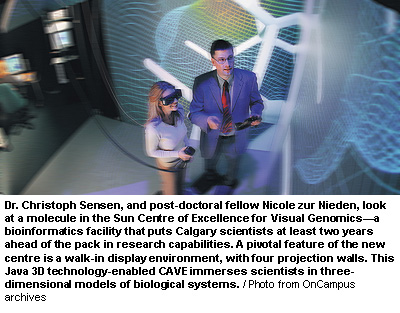 1.
Advancing health and wellness 1.
Advancing health and wellness
This
strategic academic priority addresses one of the most prominent
societal issues in Canada. This priority requires strong fundamental
work in the sciences and biomedical research, but extends to
investigations that move from the laboratory, to clinical practice,
to the population and society as a whole. A variety of perspectives
in the university bear on this priority, which includes investigations
ranging from biomedical engineering, molecular and genetic studies,
the basic life sciences, to health economics, the social determinants
of health, the ethics of health care, health policy, promotion
and delivery.
2.
Leading innovation in energy and the environment
The
City of Calgary is indisputably recognized as the energy capital
of Canada and one of the world’s major energy centres.
The University of Calgary should be positioned as the pre-eminent
university in Canada and as one of the world’s leading
centres for energy studies, including work on responsible and
environmentally-sound methods to ensure a sustainable energy
supply. This strategic academic priority is exemplified by investigations
ranging from hydrocarbon prospecting and production, fuel cell
research, alternative energy sources, water quality and supply,
to environmental management and energy transportation, environmental
law, management and energy economics.
3.
Creating technologies and managing information for the knowledge
era
A
major challenge in today’s world is the need to find effective
means for dealing with the massive amount of data and information
that is now so readily accessible. The ability to use information
effectively requires solutions from those engaged in the creation
of new devices and algorithms for information transmission and
analysis and security as well as from those developing new ways
of handling and using this information. This strategic academic
priority encompasses the work of engineers and computer scientists,
but also the work of those who assess the social implications
of the new technologies.
4.
Understanding human behaviour, institutions and cultures
Universities
play a key role both in lifting the human spirit and in trying
to explicate forms of human behaviour that are often problematic
and difficult for us to comprehend. The university seeks to
promote programs that allow us to better understand ourselves,
our capacity for creativity, our institutions, our culture and
our languages. This strategic academic priority includes investigations
in areas such as social theory and policy, cross-cultural analysis
and understanding, literary and artistic achievement, political
and ethical philosophy, public affairs and civic engagement.
Taking
action
Five
main action items will continue to direct the university’s
principle efforts, its allocation of resources, communication
strategies, fundraising objectives and government relations.
1.
Manage undergraduate enrolment to ensure that high-calibre students
are highly satisfied with the quality of their experience in
a learning environment committed to research, scholarship and
creative activity.
2.
Enlarge high-quality graduate programs, especially research-oriented
doctoral programs that support our strategic academic priorities.
3.
Identify, as a critical element in our recruitment and retention
plans for all categories of staff, the need for a close fit
between the four core principles we have adopted at the University
of Calgary and the academic and support staff who work here.
4.
Ensure that our core principles inform the future development
and review of programs at the University of Calgary, and that
they guide our thinking about the organizational structures
that support and enable those programs.
5.
Emphasize post-degree credentials, along with our regular
degrees, as the primary form of lifelong learning that a research
university
such as the University of Calgary is uniquely suited to offer.
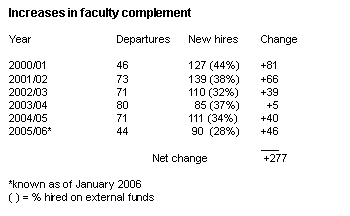 RECRUITING RECRUITING
TOP FACULTY
Over
the next four years, the university will add more than
500 new faculty positions through increased Access funds, internal
operating
funds, the launch of the Faculty of Veterinary Medicine
and
external funding. The fundraising target is 20 new chairs
in each of the next four years.
Highlights:
• Almost 400 new faculty members have joined the U of C over
the last four years. That trend is expected to continue. Deans
have identified new faculty appointments as their highest priority.
 • $2
million will be allocated to support the costs of recruitment
and creation of academic positions. • $2
million will be allocated to support the costs of recruitment
and creation of academic positions.
• Recruiting top scholars and the effective leveraging of internal
operating funds and external funding also enables
the university to enhance the quality of the student experience and expand
research activity.
•
Funding commitments will be made—in advance every year—for
planned recruitments in the following year, to ensure timely
recruitment of new faculty.
• The new Faculty of Veterinary Medicine alone will increase
faculty by 60 when fully operational.
Spousal
hires, sabbaticals: • The Provost will allocate $300,000 to pursue recruitment opportunities,
including spousal hires.
• In 2005/06, sabbatical funding was changed to allow the full
salary for faculty on sabbatical to be left in faculty budgets.
This will continue. (Previously, when a faculty member was
on sabbatical, the faculty retained only 80 percent of the salary).
Last year, more than $1.6 million was left in faculty budgets.
•
For 2006/07, faculties will also be able to use faculty turnover
as contributions to their two percent reallocation
pool. 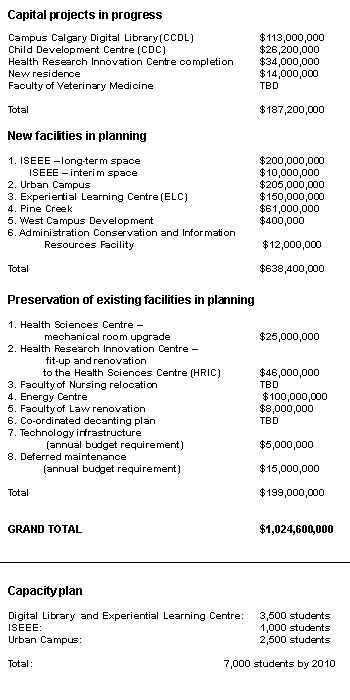 INCREASING
SPACE INCREASING
SPACE
TO MEET GROWTH
Almost
every faculty identified lack of space as a barrier to improved
student experience, effective program delivery and research
growth. Current space, including labs, classrooms and student “connecting” spaces,
is inadequate.
Highlights:
•
A comprehensive capital plan will see an incremental investment
of just over
$1 billion and the renovation of 28,000 square metres of
space.
•
These projects also significantly reduce deferred maintenance
and improve use of current space.
•
It is also critical that we add new space in the short term
to accommodate new and future faculty and staff, and space
for our students to study and interact.
•
Interim space (investment of $350,000) will be used until permanent
space is built, starting with the groundbreaking of the
Campus Calgary Digital Library last month. •
In general, interim space will be used to house administrative
and other services that don’t require highly specialized
facilities. Examples include Fund Development and Human Resources.
......... RECRUITING
TOP STUDENTS
The
university attracts top undergraduate and graduate students
by providing them with a quality learning experience and
enhancing a sense of community and involvement in campus
life. We will make it as easy as possible for students
to navigate administrative processes and increase access
to both space and technology.
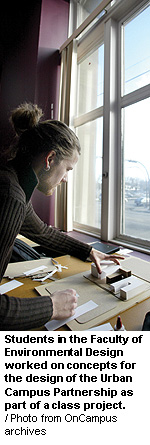 Highlights: Highlights:
•
Last year, we invested $1 million in academic merit scholarships.
This year, investment will be increased by $750,000,
with greater emphasis on students with the greatest academic
achievement.
•
Our scholarships need to compete with those offered by other
top universities. Our current fundraising target of $15 million
for scholarships for graduate and undergrad awards will grow
to $23 million over the next four years.
•
$250,000 will be spent on the Undergraduate Program Office,
supporting “one-stop shopping” for student administrative
needs.
•
Strengthening Teaching and Learning grants will total $1.25
million, to provide distinctive learning experiences,
integration of teaching and research, creative curriculum
and support
for effective and enthusiastic teachers.
•
The university will continue to invest $1 million annually
in the Learning Enhancement and Enrolment Management
initiative to reduce class sizes and create smaller tutorial
and laboratory
sections.
Graduate
student support:
•
Return of the tuition differential for international graduate
students to support graduate programs has provided more than
$4 million in the last three years and is expected to provide
an additional $2 million in 2006/07.
•
Over the next four-year business plan cycle, the university
will continue to work towards increasing the number of doctoral
students as a percentage of total graduate students. INTEGRATING
TEACHING
AND RESEARCH
Part
of the university’s reputation for experiential learning
is founded on undergraduate and graduate teaching that
integrates teaching and research.
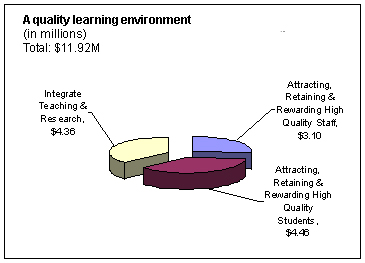 •
The 2006/07 budget includes another $600,000 for the Strengthening
Teaching and Learning Fund for a total investment of $1.25
million, to faculties to implement innovative proposals for
inquiry-based and blended-learning initiatives, including
increased opportunities for undergraduate students to participate
in research activities. •
The 2006/07 budget includes another $600,000 for the Strengthening
Teaching and Learning Fund for a total investment of $1.25
million, to faculties to implement innovative proposals for
inquiry-based and blended-learning initiatives, including
increased opportunities for undergraduate students to participate
in research activities.
•
The university will continue to use the Teaching and Learning
Centre (Learning Commons) to promote and support improved
teaching and learning.
•
In addition to an annual increase in spending of $600,000,
the university has not required the library to contribute
to the re-allocation pool (the equivalent of $200,000).
• Improving access to information for our students is also
supported by the investment of $1 million into a wireless
campus.
SUPPORT
FOR RESEARCH IS KEY
The
U of C ranks 7th in Canada in total research funding. In
addition to hiring key faculty, a significant portion of
the $80-million fundraising target will go toward research
support.
•
In 2002/03 the university began receiving federal funds
to support the indirect cost of research. The funds will
continue to be used for the ongoing infrastructure necessary
to support research, as well the university’s strategic
research priorities.
•
Funding allocations, which are provided to faculties to
support research activities and to endeavours such
as the Institute for Sustainable Energy, Environment
and Economy and the Institute for Advanced Policy Research,
will continue.
•
At this time, the indirect cost of research budget for
2006/07 will be set at $10.15 million. If more funds are
received from the federal government, they will be allocated
to previously identified priorities, including increased
support for Research Services and increased support for
post-doctoral students and areas that indirectly support
research activity, such as handling of hazardous material.
Leveraging external funding: •
The university will allocate funds to leverage opportunities
with external partners looking for a contribution from
the University of Calgary.
•
The vice-president (research and international) will have
discretionary funds of $750,000 for 2006/07, increased
from $500,000 in 2005/06.
QUALITY
INITIATIVES
A
total of $1.64 million was allocated this year to initiatives
identified by students. These initiatives were closely aligned
with the priorities of the university, including increases
in opportunities for student research, reduction in class
size and teaching support.
• For 2006/07, the Board of Governors has increased this support
to $1.76 million, again to be directed by students.
•
One of the investment opportunities currently being considered
by the undergraduate students is an investment of $250,000
that would be a match to the university’s planned investment
of $250,000 to replace the computers in the Information Commons.
• $85,000 to establish a Women’s Centre as part of Student Services
to address the
specific needs of women on campus.
• $50,000 in increased support for the International Student Centre.
• $2 million to address contingencies and unanticipated expenses.
• $2
million to address urgent faculty needs and to
support the recruitment of the best and the brightest. Urban
Campus:
Last
year, we increased our interaction with the downtown community
as a precursor to the launch of the Urban Campus. A pilot
project with the Salvation Army and
the faculties of nursing and social work, as well as the pilot dance project,
will continue in 2006/07 with $90,000 in continued funding.
Website:
The
Internet is fast becoming the primary means of accessing
information and conducting transactions. On a typical day,
the U of C homepage has 54,800 hits,
26,600 of them from off campus. As the website is now the initial point of
entry for many “visitors” to the university, we will invest $250,000 to
make improvements in design consistency and ease of navigation.
FUND
DEVELOPMENT
New
money invested by the university in fund development from
2003/04 through 2004/05 ($2.75 million annually) resulted
in total fundraising of more than $70 million this year,
up from $18.6 million three years ago. That places the
U of C among the top five fundraising performers in Canada.
These revenues will increase even more with an ongoing additional
investment of $1.5 million. The four-year targets are:
•
2006/07 - $80 million
•
2007/08 - $90 million
•
2008/09 - $100 million
•
2009/10 - $105 million
This
is a return on investment of approximately 15 to 1
Two
primary areas of focus for next year are funding for scholarships
for graduate and undergraduate students,
and
funding for faculty positions—a target of 20
chairs per year.
A
STRONG WORKING ENVIRONMENT
culture of recognition:
The
occasion of the university’s 40th anniversary creates
a great opportunity to celebrate our success and thank
the many people who have been key contributors to that
success.
An investment of $750,000 in 2006/07 will provide opportunities
for us to recognize our employees and volunteers as well
as our students, alumni, donors and the community at large.
A
safe and healthy work environment:
The
university’s commitment to a safe and healthy work
environment is demonstrated in the ongoing investment
in initiatives like the Wellness Centre. For the current
year,
the university will make a significant investment in
improving the safety of our workplace. The annual investment
of $550,000
will provide additional resources to work with faculties
and staff to ensure that everyone at the university is
committed to, and enjoys, a safe and healthy work environment.
IMPROVED
DECISION-MAKING
The
university is a large, complex organization. It is important
that we invest in our people to ensure that we have effective
leaders and it is important that we have the best information
and resources to make informed decisions and manage our
risk. The university will invest $600,000 focusing on three
strategies in this area:
•
Improve business processes, decision-making and leadership.
• Enhance
support to teaching, research and creative activities.
•
Develop strategic partnerships to create synergies and opportunities
for resource sharing. Highlights:
•
New software systems: Finance/Materials Management was implemented
this year. Student Systems and Human Resources/Payroll will
be implemented next year. Ongoing investment will be required
to provide the necessary user support. Ongoing investments
in the data warehouse in 2005/06 will facilitate distribution
of information to users across the campus that will assist
in decision making.
•
Continue investment in support staff to improve decision-making.

|